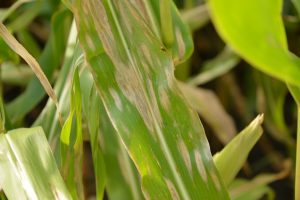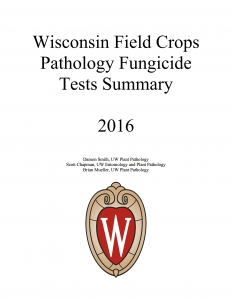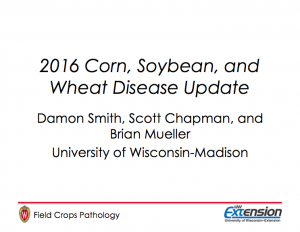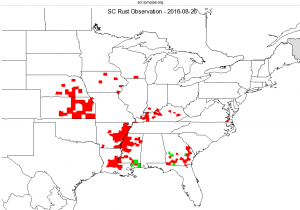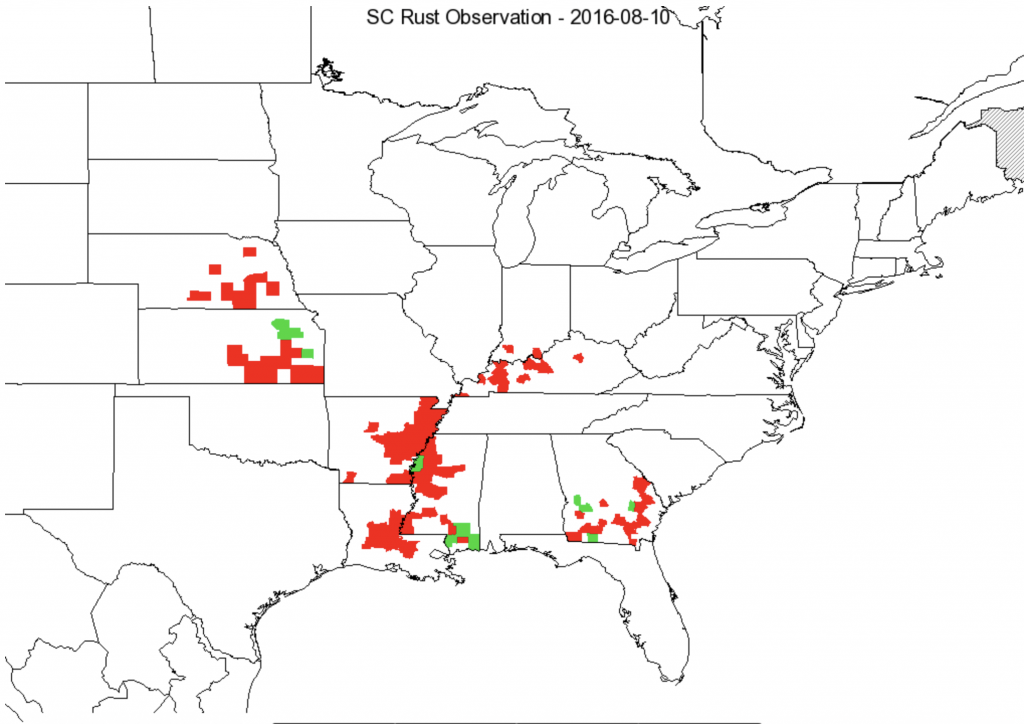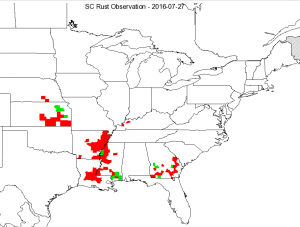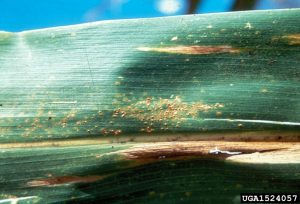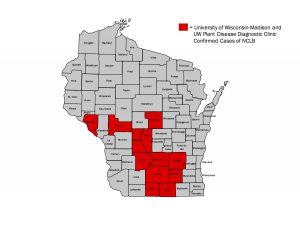Damon L. Smith, Extension Field Crops Pathologist, University of Wisconsin-Madison
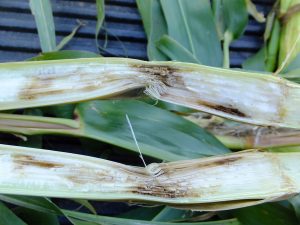
Figure 1. Anthracnose stalk rot symptoms in a cut corn stalk.
The 2016 growing season is going to end with many challenges for Wisconsin farmers. The excessively wet weather has slowed or ended harvest of corn silage and grain harvest has barely started in much of the state. Couple this with warm and wet weather is August and we have a double whammy of stalk rot and ear rot issues to contend with this fall.
What is the Primary Stalk Rot Issue in Wisconsin?
Anthracnose stalk rot (Fig. 1) has been a major concern for Wisconsin corn growers this season. Anthracnose stalk rot is typically worse in fields in a corn-on-corn rotation, and/or no-tilled, and planted to a susceptible hybrid. We have observed several fields with significant lodging and wind damage where anthracnose stalk rot has advanced quickly (Fig. 2). In other fields lodging has been minimal, but some anthracnose stalk rot can be found. In addition, to stalk rot anthracnose, we have also observed Fusarium stalk rot and Gibberella stalk rot. The occurrence of these stalk rots has been much less than that of anthracnose stalk rot.
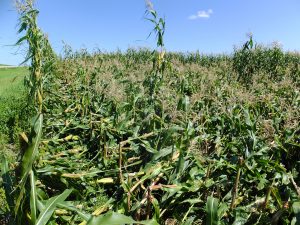
Figure 2. Corn field with considerable lodging due to anthracnose stalk rot.
Why did stalk rots start so early in 2016?
The late onset of northern corn leaf blight (NCLB) this season likely contributed to increased stalk rot this season. It has been documented that late season increase in leaf blight diseases, such as NCLB, can cause increased stress that leads to higher levels of stalk rot. Also, ears were large and yield potential appeared high this season. These large yield potentials may have led to increased scavenging of resources from stalks leading to more stalk stress. These stress issues, combined with excessively moist and mild conditions, likely led to the occurrence of higher levels of stalk rot in 2016.
What should I do if I have a field with stalk rot?
In fields were stalk rot is an issue, harvest as early as possible to avoid yield losses from lodging. Delaying harvest will increase the likelihood of lodging which will increase harvesting issues. Once conditions dry enough to allow combines to run, fields with higher levels of stalk rot and/or lodging should be prioritized for harvest.
What should I do about stalk rot for next season?
Management of anthracnose stalk rot (and for any of the stalk rots) is multi-faceted. First, choose hybrids with the best resistance available. Hybrids that also have good resistance to foliar diseases will also offer an advantage when managing stalk rot, as foliar disease can stress corn plants and lead to increased risk of anthracnose stalk rot. Cultural practices such as crop rotation and tillage to manage surface residue can also help. Other practices that reduce plant stress such as balanced fertilization, proper planting population, providing suitable drainage, and using well adapted hybrids for your location will reduce the risk of anthracnose stalk rot.
Fungicides are not recommended for managing anthracnose stalk rot. Attempts to use fungicides to manage anthracnose stalk rot often result in high variability and little translation to a yield advantage. In 2015 we conducted a corn fungicide trial where anthracnose stalk rot was detected at harvest. While higher levels of stalk rot were observed, and some treatments did lead to a significant reduction in stalk rot severity, no differences in lodging or yield were identified among the treatments. To view results of this 2015 trial, click here and scroll down to pages 2 and 3.
What corn ear rots and mycotoxins should I watch out for?
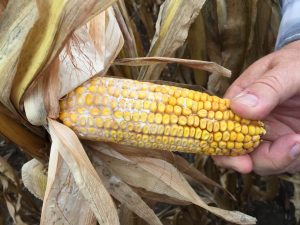
Figure 3. Moldy growth on a corn ear caused by the Diplodia ear rot fungus.
With all the wet weather late in the 2016 season, several ear rots have appeared in corn around much of the state. Ear rots caused by fungi in the groups Diplodia (Fig. 3), Fusarium, and Gibberella (Fig. 4) will be the most likely candidates to watch for as you begin harvest. Fusarium and Giberrella are typically the most common fungi on corn ears in Wisconsin. This group of fungi not only damage kernels on ears, but can also produce toxins called mycotoxins. These toxins (fumonisins and vomitoxin) can threaten livestock that are fed contaminated grain. Thus grain buyers actively test for mycotoxins in corn grain to monitor mycotoxin levels to be sure they are not above certain action levels established by the U.S. Food and Drug Administration (FDA).
The FDA has established maximum allowable levels of fumonisins in corn and corn products for human consumption ranging from 2-4 parts per million (ppm). For animal feed, maximum allowable fumonisin levels range from 5 ppm for horses to 100 ppm for poultry. Vomitoxin limits are 5 ppm for cattle and chickens and 1 ppm for human consumption.

Figure 4. Symptoms and signs of Gibberella ear rot of corn.
Diplodia ear rot (Fig. 5) is not as common in Wisconsin. However, the weather pattern this season was favorable for occurrence of this disease. This disease is often more severe in years where dry weather precedes silking, followed by wet weather immediately after silking. Diplodia ear rot does not produce mycotoxins. While this disease does not result in mycotoxin accumulation, it can cause grain yield loss and quality issues.
For more information about ear rots and to download a helpful fact sheet produced by a consortium of U.S. corn pathologists, CLICK HERE.
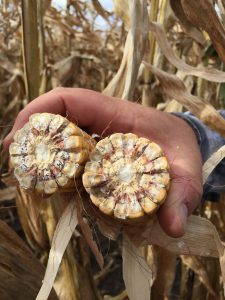
Figure 5. Signs and symptoms of the Diplodia ear rot fungus inside a split corn ear.
How do I reduce mycotoxin risks at harvest?
Before harvest, farmers should check their fields to see if moldy corn is present. Sample at least 10-20 ears in five locations of your field. Pull the husks back on those ears and observe how much visible mold is present. If 30% or more of the ears show signs of Gibberella or Fusarium ear rot then testing of harvested grain is definitely advised. If several ears show 50-100% coverage of mold testing should also be done. Observe grain during harvest and occasionally inspect ears as you go. This will also help you determine if mycotoxin testing is needed.
If substantial portions of fields appear to be contaminated with mold, it does not mean that mycotoxins are present and vice versa. Remember, Diplodia ear rot does not produce mycotoxins. However, if you are unsure, then appropriate grain samples should be collected and tested by a reputable lab. Work with your corn agronomist or local UW Extension agent to ensure proper samples are collected and to identify a reputable lab. If tests show high levels of mycotoxins in grain, that grain SHOULD NOT BE BLENDED with non-contaminated corn.
For more information on mycotoxins and to download a fact sheet, CLICK HERE.
Helpful information on grain sampling and testing for mycotoxins can be found by CLICKING HERE.
For a list of laboratories that can test corn grain for mycotoxins, consult Table 2-16 in UW Extension publication A3646 – Pest Management in Wisconsin Field Crops.
How should I store corn from fields with ear rots and mold?
If you observe mold in certain areas of the field during harvest, consider harvesting and storing that corn separately, as it can contaminate loads; the fungi causing the moldy appearance can grow on good corn during storage. Harvest corn in a timely manner, as letting corn stand late into fall promotes Fusarium and Gibberella ear rots. Avoid kernel damage during harvest, as cracks in kernels can promote fungal growth. Also, dry corn properly as grain moisture plays a large roll in whether corn ear rot fungi continue to grow and produce mycotoxins. For short term storage over the winter, drying grain to 15% moisture and keeping grain cool (less than 55F) will slow fungal growth. For longer term storage and storage in warmer months, grain should be dried to 13% moisture or less. Fast, high-heat drying is preferred over low-heat drying. Some fungi can continue to grow during slow, low-heat drying. Also, keep storage facilities clean. Finally, mycotoxins are extremely stable compounds: freezing, drying, heating, etc. do not degrade mycotoxins that have already accumulated in grain. While drying helps to stop fungal growth, any mycotoxins that have already accumulated prior to drying will remain in that grain. The addition of acids and reducing pH can reduce fungal growth but will not affect mycotoxins that have already accumulated in harvested grain.
For more information on properly storing grain and to download a fact sheet on the subject, CLICK HERE.
References
This article is a compilation of the following previously written resources:
Smith, D.L. 2016. Wisconsin Late-Season Corn Disease Update. /2016/09/07/wisconsin-late-season-corn-disease-update/.
Smith, D.L. and Mitchell, P. D. 2016. Wet Wisconsin: Moldy Corn and Crop Insurance. http://ipcm.wisc.edu/blog/2016/09/wet-wisconsin-moldy-corn-and-crop-insurance/.

